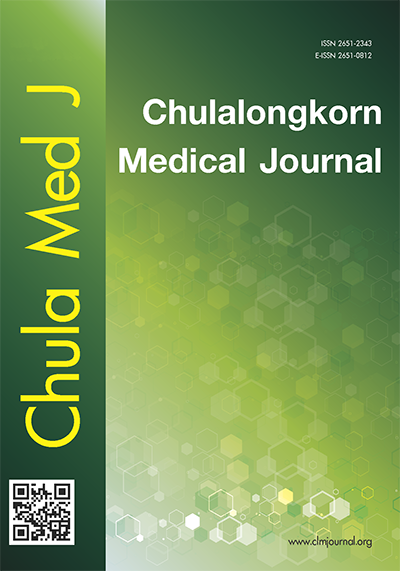Prevalence and severity of allergic diseases in Thai children in Phitsanuloke Province
Keywords:
Prevalence, Allergy, Risk, ChildrenAbstract
Backgrounds : The number of Thai children affected by allergic diseases is increasing. However the studies regarding their prevalence, severity, risk factors and treatments have not yet been systematically performed.
Objectives : To study the prevalence, seventy, and risk factors of allergic diseases in children.
Materials and Methods : We conducted a cross-sectional descriptive study. Grade 1 - 6 students (aged between 6 - 11.9 years old) at Jakanboon School and grade 7-12 students (aged between 12-18 years old) at Janokrong School in Phitsanuloke were recruited. The modified ISAAC questionnaire (International study Asthma and Allergy เท Children) was used for data collection. The association of risk factors and allergic diseases was analyzed by binary logistic regression model.
Results : The questionnaire of 3,164 students were evaluated (response Conclusion rate 60.3%). There were 36.3% of students aged between 6-11.9 years and 63.7% of students aged between 12 to18 years old with the mean age of 9.67±1.60 years old and 15.27±1.69 years old, respectively. The prevalence of allergic rhinitis (AR), asthma, allergic conjunctivitis (AC), atopic dermatitis (AD), urticaria, food allergy and drug allergy were 47.9%, 5.5%, 29.5%, 21.2%, 22.2%, 9.8%, and 1.0% respectively. In AR, the frequency of persistent AR was 56.0% while the frequency of intranasal corticosteroid use was only 1.3%. In asthma, mild intermittent asthma was the most common (43.9%). The admission rate was 13.3%. The mean occurrence of exercise-induced bronchospasm and asthma in the past year was 49.1% and 67.6%, respectively. The mean inhaled corticosteroid use was 7.9%.
The coexisting conditions, asthma and AR were found in 7.7% and 65.5% of AD patients, respectively. Similarly, asthma and AC were found in 9.6% and 55.6% of AR patients. Positive family history of atopic diseases was significantly associated with all allergic diseases in both age groups. In addition, exposure to cigarette smoke was associated with AR in both groups. However, exposure to cigarette smoke was significantly associated with asthma only in the young age group.
Conclusion : The prevalence of allergic diseases in Thai children in Phitsanuloke was still high. There were a high percentage of patients with severe symptoms as assessed by rate of admission and asthmatic attack. The intranasal and inhaled corticosteroids were rarely used. Family history of atopic disease and exposure to cigarette smoke were associated with allergic diseases.
Downloads
Downloads
Published
How to Cite
Issue
Section
License
Copyright (c) 2023 Chulalongkorn Medical Journal

This work is licensed under a Creative Commons Attribution-NonCommercial-NoDerivatives 4.0 International License.










